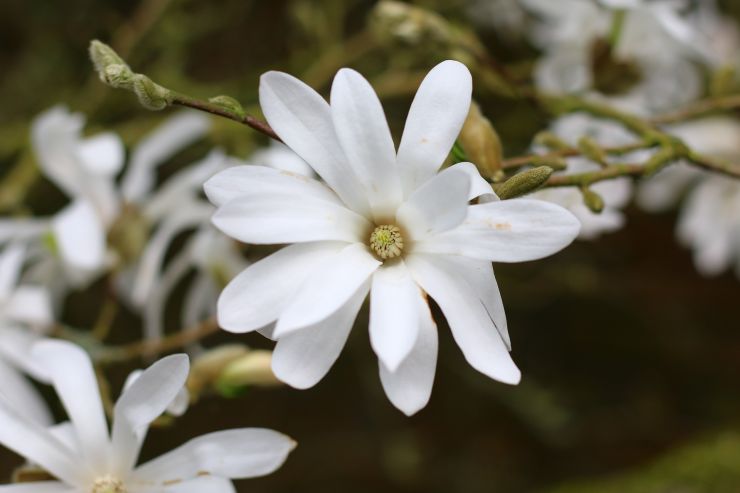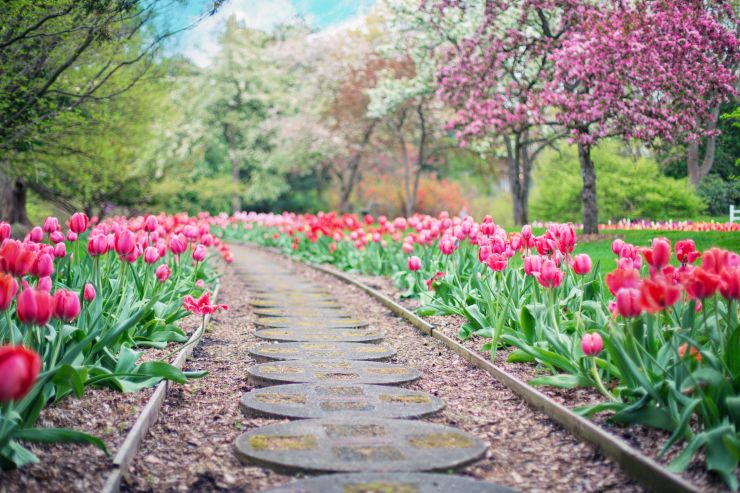What To Do In April

‘The Flowers of Tomorrow are in the Seeds of Today’
An Indian Proverb made for April
In the gardening calendar, April denotes mid spring. April is a month of contradictions – wild and windy with April showers one day, sunny and warm like summer the next or a crazy mix of contrasting weather all on the same day, hour or even minute! It’s prized for both endings and beginnings and this fourth month in the calendar is named for the Greek goddess of love, Aphrodite. In the Roman calendar, April was spelled Aprilis (meaning ‘to open’). The festival of Parrilla fell in April, which was a day that celebrated the founding of Rome. So, all in all, April is an exciting month with lots going on. For 2018, Easter Day shares 1st April with April Fool’s Day. The last time that happened was 1945. We might see lots of excited children waking up to an absence of Easter eggs, only to be met with the cry of April Fool’s (or Poisson d’avril if you happen to be French)!
It’s a month of rebirth and renewal, when the trees and flowers begin to burst into life. What an amazing month to make the most of the garden and make merry with an Easter egg hunt or marvel at the baby bunnies, scampering through the undergrowth.
Now that the weather is warming up, it’s time to de-clutter the winter debris and look ahead to the sun-laden days of summer. Breathe in the fresh air and start to plan, sow and plant your summer-flowering plants for a brilliant display of colour and scent. Check out anything you planted back in the autumn and look after the new spring growth.
In the greenhouse, it’s non-stop activity. Seedlings to be pricked out, hardened off and planted out into ready-prepared beds. There’s no shortage of jobs as everything seems to happen at once. Pace yourself though and get around to everything in your own good time. Gardening should remain chilled and stress-free – we need this grounding activity to keep us sane and happy. Prioritise and plan and do the most urgent first.
Now that it’s warming up, it’s insulation off in the main and time to think about shading. Young plants can suffer from scorching, so set up some shady areas in the greenhouse to keep them happy and lush. The nights can still be chilly, so you could leave some insulation in place to counteract this. And keep an eye out for pests that like the juicy new growth of budding plants – aphids, whitefly and Vine weevil larvae are all around in April.
IN THE GREENHOUSE
- Keep sowing greenhouse crops
- Continue sowing and pricking out bedding plants (Cosmos, Petunia, Nicotiana)
- Begin hardening off more advanced seedlings
- Sow wallflowers in a nursery bed for flowers next spring
- Sow herbs
- Sow French beans and sweetcorn
- Sow marrows, courgettes, outdoor pumpkins
- Sow Savoy cabbage and kale
- Start achimenes and sinningias into growth
- Pot on ornamental plants making new growth as well as citrus
- Give succulents and cacti a good soak to welcome in the spring after their long winter rest
- Plant sweet potato slips in an unheated propagator
- Sow melons and passionfruit for indoors
- Plant rooted chrysanthemum cuttings, check your other cuttings and plant if required
- Take cuttings of Dahlias. Shoots will soon grow, and these can be taken as basal cuttings.
- As spring bulb leaves die down, dry off the bulbs and remove offsets to grow on.
AROUND THE GARDEN
Ornamental Garden
- Prune early flowering shrubs like Forsythia and Chaenomeles once they’ve finished flowering
- Buy water plants for ponds so they can establish roots as the water warms up
- Feed roses with a special rose fertiliser
- Plant Mediterranean shrubs like Cistus and Hebe
- Plant summer-flowering bulbs and corms like Gladioli, Lilies,Raniculus, Dahlias and Begonias.
- Renovate evergreen shrubs
- Feed border plants – boost sturdy new growth by sprinkling the roots with a balanced feed like blood, fish and bone
- Divide crowded perennial plants – some can be teased apart with your hands, while others can be levered apart with a pair of hand forks
- Feed spring-flowering bulbs (daffodils/tulips/crocuses) with a slow-acting fertiliser. This will plump them up for better blooming next year.
- Tackle weeds – chickweed, creeping buttercup, dandelions, daisies, thistles and many others will all be making a beeline for the border!
- Look out for mildew and treat appropriately with a fungicide
Kitchen Garden
- Plant out pot grown broad beans
- Plant chitted potato tubers, starting with first earlies at the beginning and maincrop at the end of the month
- Start formative pruning of cherry and plum trees, once leaf buds open
- Sow vegetables direct, including carrots, lettuce, spring onions, peas, leeks, radish, turnip, beetroot and perpetual spinach
- Towards the end of the month, plant tender vegetables like courgettes, squashes, pumpkins and French beans
- Protect the blossom of trees like pears, if frost is in the forecast
Wildlife
Before trimming hedges, ensure birds are not nesting
If going on holiday, gradually reduce the amount of bird food you provide for your feathered friends, to avoid a sudden halt to their supply
Keep an eye out for hedgehogs and frogs when emptying compost or moving large piles of leaves, in case they are still hibernating

And, if you’d like to get out and about this spring, take a tip from The Telegraph’s guide to The 50 Best Gardens to visit in Spring to soak up some inspiration. Wherever you are in the UK, there’s a garden waiting to be discovered, choose from one of these:
1. Evenley Wood Garden, Northamptonshire
2. Knightshayes, Devon
3. Bodnant Garden, Conwy
4. Holker Hall, Cumbria
5. Killerton, Devon
6. Batsford Arboretum, Gloucestershire
7. Great Comp Garden, Kent
8. Pashley Manor, East Sussex
9. Sir Harold Hillier Gardens, Hampshire
10. Brockhampton Estate, Worcestershire
11. Greencombe Gardens, Somerset
12. Borde Hill Garden, West Sussex
13. Antony Woodland Garden, Cornwall
14. The Savill Gardens, Berkshire
15. Cragside, Northumberland
16. Exbury Gardens, Hampshire
18. Stourhead (National Trust), Wiltshire
19. Caerhays Castle, Cornwall
20. High Beeches Gardens, Sussex
21. West Dean, West Sussex
22. Packwood House, Warwickshire
23. Helmingham Hall, Suffolk
24. Tatton Park, Cheshire
25. Audley End, Essex
26. Hardcastle Crags, West Yorkshire
27. Foxley Wood, Norfolk
28. Bowdon Woods Nature Reserve, Berkshire
29. Gilfach Farm Nature Reserve, Powys
30. Sydenham Hill Wood, Southwark, London SE26
31. Cliveden, Berkshire
32. Rousham House and Garden, Oxfordshire
33. Alnwick Castle Garden, Northumberland
34. Wrest Park, Bedfordshire
35. Eltham Palace, London SE9
36. Penshurst Place, Kent
37. Wyken Hall, Suffolk
38. Doddington Place, Kent
39. St Paul’s Walden Bury, Hertfordshire
40. Bowood House, Wiltshire
41. Coleton Fishacre, Devon
42. Cambo Country House and Estate, Fife
43. Ulting Wick, Essex
44. Stockton Bury Gardens, Herefordshire
45. Wentworth Castle, Yorkshire
46. Picton Castle, Pembrokeshire
47. Penjerrick Garden, Cornwall
48. Fairhaven Woodland and Water Garden, Norfolk
49. Lydney Park Gardens, Gloucestershire
50. Inverewe, Rossshire
 Author:
Author: